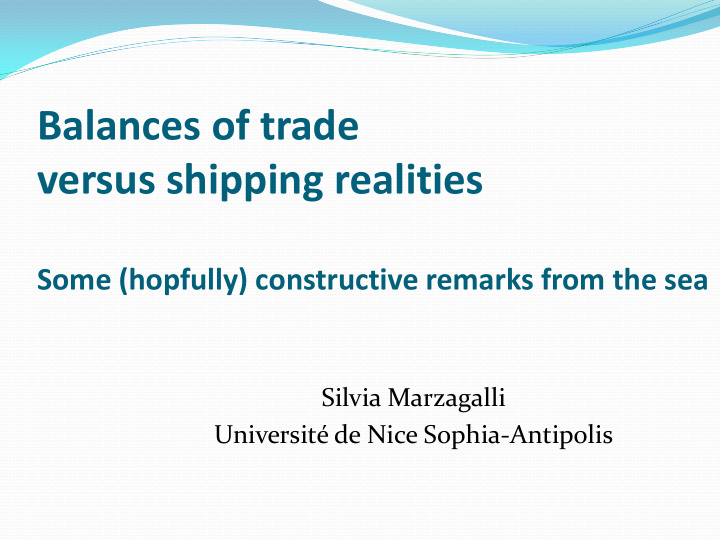



Balances of trade versus shipping realities Some (hopfully) constructive remarks from the sea Silvia Marzagalli Université de Nice Sophia-Antipolis
1. Balances of trade are inadequate to capture the nature of apparent imbalances of trade
Imbalances between two countries can be generated by a huge difference in prices between markets (see Morineau, next slide) or imply a real imbalance which requires a flow of payments to balance it (other case study by Morineau on trade between France and The Netherlands)
Value cargo at departure from Bordeaux Sale value at Léogane Cargo bought at Léogane Value cargo sold in Bordeaux Michel Morineau , « Quelques recherches relatives à la Balance du Commerce extérieur français au XVIIIe s.: ou cette fois un égale deux », Aires et structures …, 1975
2. Problems of matching balances
When comparing French and US- statistics to reconstruct the evolution of the trade between the two countries during the French Wars, trends are consistently similar eastwards and much more inconsistent westwards (see two following slides) However, even in the case of eastward trade, difference in values are hight (approx. 50 %); They varies between 30% and 90% for the westward trade, depending on years
Unbalanced balances. Trade between France and the US (eastwards), 1790-1815 millions de francs millions de $ 120 14 12 100 French imports from US (F) NB: 1 US-$ = 5 F US exports to France ($) 10 80 8 60 6 40 4 20 2 0 0 1790 1792 II IV VI VIII X XII XIV-1806 1808 1810 1812 1814 Sources: Statistical Tables Exhibiting the Commerce of the United States with European Countries, from 1790 to 1890, Washington, Government Printing Office, 1893 ( 1893) ; PITKIN, 1816; AN, F 12 501 A ; Statistiques de la France ( 1838 ); VILLIERS (1991)
Unbalanced balances. Trade between France and the US, westward millions de francs millions de $ 16 1,2 14 1 12 NB: 1 US-$ = 5 F 0,8 10 8 0,6 6 0,4 4 0,2 2 0 0 III V VII IX French exports to US (F) US imports from France ($)
Explaining 50%-90% « ghost » values Insurance and freight Vessels captured by British [cross-check of ship- departures and ship arrivals tend to demonstrate that ships did actually arrive at destination, with the exception of a few years] Interest of US-merchants to declare reduced values when importing (wine is taxed 23% ad valorem, brandy 35%) Interest of inflating export values for French merchants after 1810 (to increase possibility of importing)
3. Bilateral conceptions versus networks. The last leg (or first destination) of maritime flows is not necessarily adequate to understand the circulation of goods
Complexification of US shipping routes during the French Wars. The case of Bordeaux 1791 1796-1815 S. Marzagalli, « Establishing Transatlantic Trade Networks in Time of War : Bordeaux and the United States, 1793- 1815”, Business History Review , 79 (2005), p. 811-844 .
Foreign trade of the United States, 1790-1815 thousands of US- $ 160000 imports 140000 reexports 120000 exports 100000 80000 60000 40000 20000 0 1790 1792 1794 1796 1798 1800 1802 1804 1806 1808 1810 1812 1814 Source : Douglass C. NORTH, « The United States Balance of Payments, 1790-1860 », in Trends in American Economy in the Nineteenth Century , 1960. When reexport trade is essential, and when trade routes are influenced by warfare, balances of trade on a country-by-country are absolutely inadequate to understand trade flows
Ex. of a complexe shipping pattern which is not captured by balances of trade: Sukey of Salem Balance of trade : export to France; import from Spain Sources: Peabody Essex Museum, Salem Clearances of Foreign Vessels, microfilm #129 and Salem Impost Book, microfilm #29, reel 5. NARA, RG 84, Palermo 144 et Bordeaux 225 (actually Marseille) ; The People's Friend & Daily Advertiser , 17 Octobre 1806; Daily Advertiser , 1 Decembre 1807;
Other ex. (not linked to warfare) of complexe tramping: a Mediterranean caravane. Captain Jospeh Martin, 1739- 1742 G. Buti, « Cabotage et caboteurs de la France méditerranéenne (XVIIe-XVIIIe siècles) » (2003)
4. Joining efforts ?
a programme financed by the Agence Nationale de la Recherche (December 2007- December 2011)
Navigocorpus An international project coordinated by : Silvia Marzagalli (Centre de la Méditerranée moderne et contemporaine, Nice) Pierrick Pourchasse (Centre de Recherche Bretonne et Celtique) Jean-Pierre Dedieu (Laboratoire de recherche historique Rhône-Alpes) • Werner Scheltjens (Post-doctoral Fellow, 2008-2010) and an international network of researchers throughout Europe
Navigocorpus Goals : To create a relational data-base of ships voyages. The base contains approx. 400 000 voyages (late 16th – 19 c.) To put the base be on-line and to facilitate its use (codes, cartography, dictionnaries of goods and measures, etc.) To insure the perennity of the data-base and its progressive growth.
Navigocorpus. A data-base on shipping and trade ?
Detecting false declared destinations : Smogglers to England Declared destination from Dunkerque: « Lissabon » (but real destination is England) 1/3 of shipping tonnage from North France to GB (1787) consisted in smuggling
A possible link to balances of trade ? . 91 Ports for which G5-series at the National Archives (Paris) 1787 details on each clearing ship are known ; for 65 other ports, data on number of ships only Total known details: 30000 out of approx. 45000 clearances (a fifth being foreign . ships) NB: map need Presentation of to be updated results: + Corsica Archives Nationales, + some 24 May 2011 colonial ports
Conclusion Possibility of concentrating on a relevant item or group of items and track through shipping data-bases and balances of trade its circulation (volumes, values, etc.) Possibility of providing elements for countries where the balance of trade do not provide data on geographical destinations/origins of trade flows (provided trade is maritime) Necessity of joining forces (specially in establishing a dictionnary of goods)
Recommend
More recommend